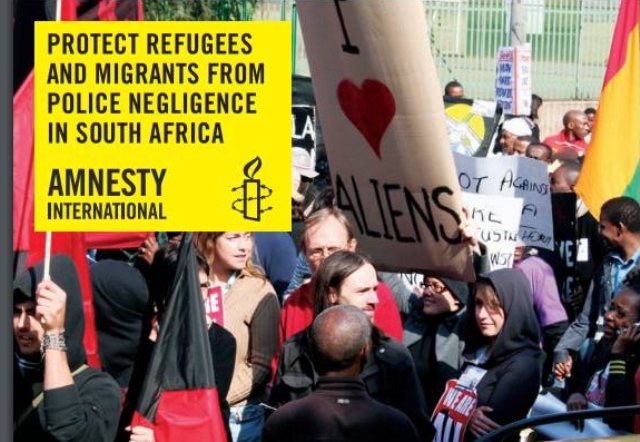 Amnesty International 2010 postcard for campaign on migrants' rights in South Africa.
Amnesty International 2010 postcard for campaign on migrants' rights in South Africa.
[This is an excerpt from an article appearing in the current edition of The Round Table: The Commonwealth Journal of International Affairs].
Violence Against African Migrants in South Africa
Crush and Ramachandran note that ‘migration from developing to developed countries has been accompanied by growing resentment of immigrants and refugees. While xenophobic sentiment continues to be strongly entrenched in developed countries, it is increasingly prevalent in developing countries as well’. South Africa has established itself as one of these countries, displaying some of the most brutal and inhumane treatment of people of foreign origin.
The screams of the burning Mozambican still haunt me. When I close my eyes to try to sleep, I see the man screaming for help. But no-one helps him . . . I have never seen such barbarism. I cannot stand this kind of life. (BBC, 2008)
These were the words of Thabiso, a 36-year-old Zimbabwean woman who witnessed the brutal murder of her Mozambican neighbour in a South African informal settlement in 2008. For most African foreign nationals living in South Africa, the years 2008 and 2015 were ones filled with horror and fear. These were the years when South Africa’s rising intolerance of foreign nationals and growing culture of xenophobia (Human Rights Watch, 1998) matured into mass violence.
The 2008 attacks left approximately 60 people dead, 20,000 displaced and 342 shops looted. The most immediate identifiable precursor to this attack appears to be a service delivery protest in the township of Alexandria in Gauteng province. The violence soon spread to other townships and provinces. The second pogrom in 2015 began in Isipingo, KwaZulu-Natal, and quickly spread to nearby KwaMashu, Umlazi, Chatsworth and to the capital, Pietermaritzburg. This attack, initially on 120 foreign nationals, left seven people dead and many displaced. Homes and shops of foreign nationals were also looted and damaged. The KwaZulu-Natal attack has been associated with a labour dispute between local and foreign nationals, but was also linked to Zulu King Goodwill Zwelithini’s statements about South Africa’s porous boundaries allowing illegal immigration and criminal activities. In both 2008 and 2015 some South Africans were killed because of mistaken identity based on physical appearance.
According to Crush and Pendleton, xenophobia is defined as ‘hatred or fear of foreigners and strangers (“the other”), which can be expressed in murder, violence, discrimination, verbal abuse and public hostility’. The ongoing, daily discrimination against foreign nationals in South Africa and the two occasions of mass, murderous violence satisfy the above definition. However, the charge of xenophobia is contested in South Africa. Many South African leaders and citizens deny such categorisations. Furthermore, some scholars believe that this is xenophobia of a special type, with the descriptors of Afrophobia, negrophobia and racism being offered. But foreign nationals, like those whose narratives are presented below, are clear that what they experience is xenophobia, and the fear and violence that characterise this xenophobia compound the trauma of previous episodes of violence in their lives. Not only are definitions contested, but also estimates of the actual number of undocumented migrants in South Africa varysignificantly, from 2 million to 12 million. The correct figure is more likely to be closer to the lower estimates.
A substantial body of literature has been developed on xenophobia-related violence in South Africa. This covers direct accounts of the experiences of foreign nationals in their places of refuge in South Africa. However, the violence giving rise to their migration is not often included and presented as continua of violence. This is not just an empirical neglect; many foreign nationals bemoan this lack of understanding and believe that if their violence-wracked life stories were more widely known they might receive better treatment in this land that they were forced to come to. This article seeks to address this lacuna in the literature by exposing the continuum of violence as revealed by a group of foreign nationals in the Community Peace-Building Project in KwaZulu-Natal, South Africa.
The Community Peace-Building Project
The data drawn on in this article were collected during an intervention with South Africans and their neighbours of foreign origin in Pietermaritzburg, KwaZulu-Natal.
Soon after the second spate of deadly attacks on foreign nationals in 2015 the Community Peace-Building Project was initiated to explore the conflict and how better relationships could be developed. This collaborative project between staff of the University of KwaZulu-Natal (UKZN) and two local non-governmental organisations (NGOs), the Pietermaritzburg Agency for Community Social Action and Sinomlando, developed and ran workshops with both local nationals and foreign nationals to deepen understandings of the contested phenomenon of xenophobia and foster conversations on how relationships could be improved. Key among the project’s objectives were:
‘Creating a space for dialogue between local nationals and foreign nationals’ and ‘Developing a better understanding of the complexity of the problem commonly described as xenophobia’.
While these were our objectives, participants expressed hopes that the workshop might help them gain knowledge as to why the local South Africans mistreat them and why there is poor response and support from the South African government with statements such as: ‘Why are South Africans mistreating foreigners? I hope I will gain understanding to this’; and ‘I would like to understand why foreigners are treated as less human and the government isn’t doing anything. There are foreigners in all countries but in South Africa they are not well received, why?’
Vaughn Mitchell John is with the School of Education, University of Kwazulu-Natal, Pietermaritzburg, South Africa.



